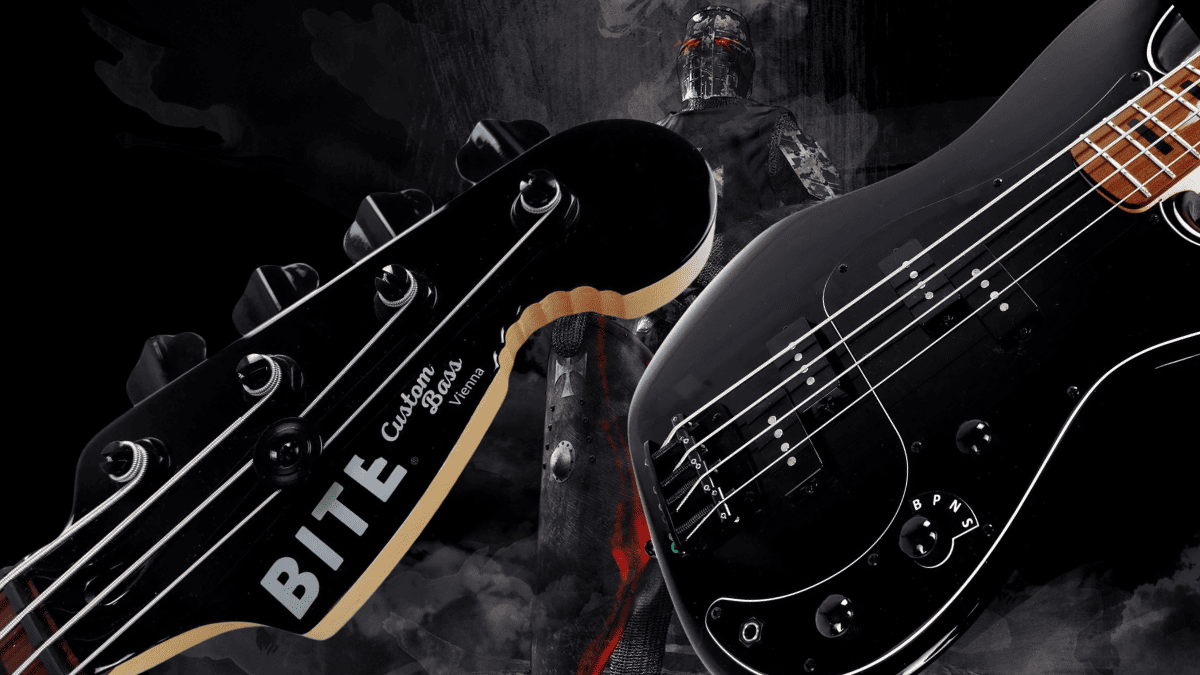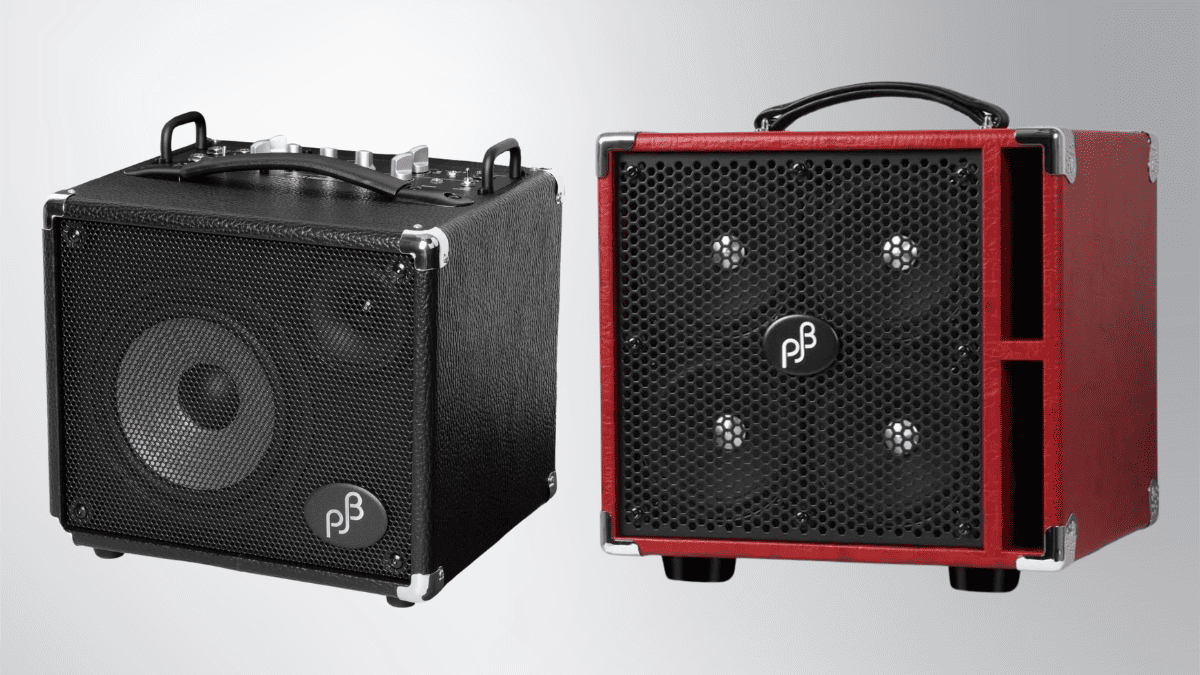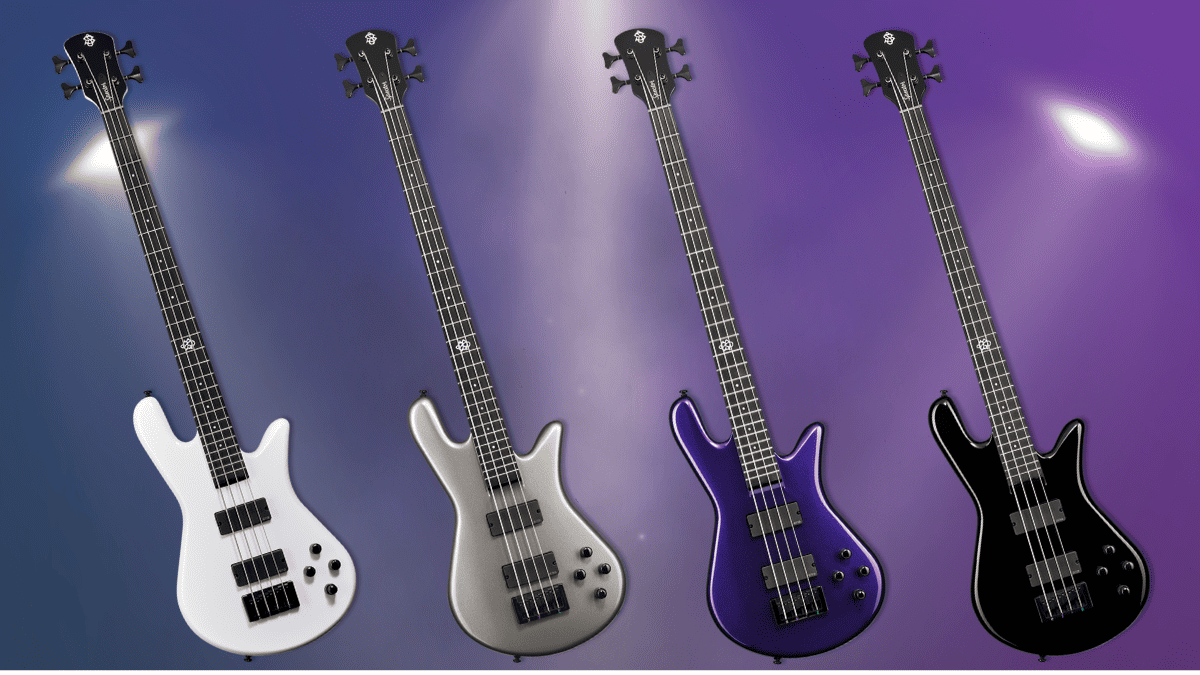Gear Reviews
There and Back Again My Weekend with the Gruv Gear Stadium Bag by Jonathan Moody


Friday:
1 – Gig at High School Cabaret (Warwick Streamer LX, PJB Briefcase amp, dress black attire)
2 – Gig at Late Night Cabaret (Warwick Streamer LX, PJB Suitcase amp, effects, dress casual attire)
Saturday:
3 – Rehearsal at Civic Theatre (NS Design CR-5M, PJB Bass Cub amp, no dress code)
4 – Gig at High School Cabaret (Warwick Streamer LX, PJB Briefcase amp, dress black attire)
5 – Gig at Late Night Cabaret (Warwick Streamer LX, PJB Suitcase amp, effects, dress casual attire)
Sunday:
6 – Rehearsal / Service at local Church (Warwick Streamer LX, direct box, dress attire)
7 – Gig at High School Cabaret (Warwick Streamer LX, PJB Briefcase amp, dress black attire)
8 – Rehearsal at Civic Theatre (NS Design CR-5M, PJB Bass Cub amp, no dress code)
As you can see, shoving everything I could into the pockets of a gig bag would not work in this situation. Plus, I’m just not that guy. The bag ends up getting heavy (and with a 6 string bass, it’s already heavy enough), and in my situation, won’t work from gig to gig. So, I carry an “accessory” bag with all of the miscellaneous items, allowing me to take that bag to whatever gig or rehearsal and still have everything I need. For a long time, my bag of choice was the Access PFX-1, which is a great bag for the gigging musician. I don’t know of any other bag that has as much functionality and customization options as it does. However, I quickly realized two things that the PFX-1 didn’t have for my needs; some sizable pockets (the bulk of the pockets are quite small, despite their convenience), and space to hold a theatre score. While you could easily walk into a theatre with the score in your hand (and I’ve done it), the days of inclement weather (I do live in Michigan, after all) have proven a need for a better solution.

It also comes with a rain/weather cover that you can easily put over the entire bag when dealing with that inclement weather I previously mentioned. It’s attached to the bottom of the bag, and easily stows away when not in use. While I had no use for it during the “perfect storm” of gigs, I can say that during the rainy/snowy month of December that it came in handy. You do lose the use of the top carrying handle when deploying the cover, but the other three carrying options are still usable, so it’s really no big deal.
While it doesn’t have the number of pockets as the PFX-1, I quickly found that I preferred the fewer, bigger areas that the Stadium Bag provides. I can throw a couple of bigger items into the different compartments and still have some room, instead of cramming pockets shut and hoping the zipper will close. For someone that carries three instrument cables and a power strip regularly, putting them in one compartment instead of three was nice.
In the field, the bigger compartments proved very useful. On Saturday, I was able to keep two changes of clothes in the bottom of the bag, cords and effects in the middle, and my headphones, power strip and adaptors in the top. The front pocket also held a binder of music, a theatre score and my iPad in addition to some smaller incidental items. Even the interior color of this bag proved useful. While it is Gruv Gear’s signature color of orange, it also serves a double purpose by making it easy to open up the bag and quickly see what is in the compartment. Black interiors are great, but I find myself rifling through everything to find that one cord.
Racing between my car and the venues, I was able to utilize a couple different carrying options that the Stadium Bag offers; backpack straps and the V-Cart option. It also has a carry handle and a shoulder strap, which I didn’t use but assume they function as expected. The nice thing about the V-Cart option is that it can attach to the underside of the cart handle, leaving the front area clear to carry more gear. With that, I was able to put the PJB Suitcase, Warwick bass and Stadium Bag on my V-Cart and walk in to the Late Night Cabaret easily without fighting with a door. This is a big plus because with a bag of this size, it gets heavy when you fill it…especially on gig 5 when load-in is at 11pm.
So all in all, the Stadium Bag by Gruv Gear proved to be a very worthwhile investment in helping keep me organized as I navigated the “perfect storm” of gigs that weekend. It has quickly become my “go to” bag; it’s currently sitting in the corner of my room, full of gear for my church gig and current theatre run. This bag was made with some real world applications in mind and it shows in its ease of use and functionality.
For more information on the Gruv Gear Stadium Bag, visit gruvgear.com
Gear Reviews
Review Transcript: BITE Custom Bass – The Black Knight PP Bass

This is a written transcript of our video review of the BITE Custom Bass Black Knight PP Bass originally published on March 4, 2024
BITE Custom Bass – The Black Knight PP Bass Review…
Bass Musician Magazine did a review on a Steampunk bass from BITE Guitars about three years ago, it was an amazing instrument, and we were very impressed. Now we’re happy to bring you another BITE bass, the Black Knight PP.
Everybody needs a P-type bass, it’s the standard of bass. If you’re recording, they want you to have a P bass. So why not have something that gives you a little more by having two instead of one P pickup. That’s the idea of this bass, it’s the first thing that leaps out: the double P pickup configuration.
Installing two of their 1000 millivolt split-coil pickups, BITE then went one step further and wired them up in a 4-way parallel/series circuit, a look at the controls reveal a 4-way rotary selector:
The first position, marked “B”, gives you the bridge pickup by itself.
The second position, marked “P”, gives you the bridge and neck pickups in parallel mode, that’s the traditional J-type circuit, it reduces output due to the physical law of parallel circuits.
Position number 3 is marked “N”, it gives you the neck pickup by itself.
And finally, number 4, marked “S”, gives your bridge and neck in a series (humbucking) mode which adds up resistances and thus boosts output. The other two controls are master volume and master tone.
What’s more, like every BITE bass, this one also has a reinforced headstock heel designed to give it extra output and sustain. The BITE website features a graph and explanation of what they have done to the heel, as compared to traditional headstocks.
A look at the body reveals a beautiful Black Blast body finish and underneath that we have alder wood. The bass has a matching headstock with a 4-in-line tuner setup and the traditional bite out of it, so everybody will know what kind of bass you’re playing. The pickguard is 3-ply black, the neck is vintage tinted hard maple and it has a satin speed finish at the back which keeps your thumb from sticking.
On top of that, there’s a clear-coated roasted black locust fretboard with black blocks marking the frets. The nut is a black Graph Tec nut, we’ve got diamond dome control knobs, and the tuners are lightweight compacts with cloverleaf buttons and a 1:17 ratio precision gear. The bridge is a Gotoh brass bridge with 19-millimeter string spacing.
Overall measurements: we’ve got a standard 34″ scale, a 1.65″ width nut and a C neck profile. This bass weighs 8.2 pounds, or 3,7 kilograms for our metric friends, and it uses standard 18% nickel silver frets.
Taking a closer look at the sound, this bass is a joy to play. The BITE proprietary 1000 millivolt pickups deliver an extraordinary amount of output which is surprising considering this is a passive instrument. You may even want to set your amp to active mode because of all of the juice you’re getting out of this guy.
The tonal possibilities are very versatile, it’s a straight P if you want but also much more with those different arrangements of the circuitry. So why have multiple basses when you’ve got one that can give you your basic P plus a lot more?
To sum it up, the Black Knight PP is an amazing instrument. The attention to detail that BITE puts into their basses is second to none. This bass is also amazingly balanced and gorgeous to hold and feel with the satin neck finish.
For more information, visit online at bite.guitars/product/black-knight-pp
Bass Videos
Reviews: Phil Jones Bass Compact Plus 450 and Bass Engine 17

Phil Jones Bass Compact Plus 450 and Bass Engine 17 Reviews…
In this issue, we take an in-depth look at two new amps from Phil Jones Bass, the Compact Plus 450 and Bass Engine 17.
For more information, visit online at pjbworld.com
Bass Videos
Video Review: BITE Custom Bass – The Black Knight PP Bass

BITE Custom Bass – The Black Knight PP Bass Review…
I am sure many of you saw my review of the Snobby Steampunk Bass from BITE Guitars back in February of 2021 and will remember what a remarkable bass it was. BITE has been building custom basses since 2019 and has a unique custom approach where you can configure your bass to your specs.
I am very excited to have another Bass From BITE Guitars in my hands, The Black Knight PP Bass!
The need for a P-Bass in one’s armamentarium is pretty standard for bass players and I recall chatting about this with Marty O’Brien about a year ago. It turns out that Marty and BITE Guitars got together and came up with this excellent configuration that gives you a P-Bass with a whole lot more. Marty even played his own Black Knight PP bass at the 2024 NAMM show. You can see his review here.
Join me as I take an in-depth look at this very cool instrument and share all the details.
Here is The Black Knight Bass from BITE Guitars!
For more information, visit online at bite.guitars/product/black-knight-pp
Gear Reviews
Gear Review: Origin Effects Cali76 Compact Bass

Origin Effects Cali76 Compact Bass Review…
Throughout the evolution of music, bass players have sought tools to sculpt and enhance their sonic landscapes, and one indispensable ally in this pursuit has been compression. Origin Effects, a name synonymous with premium audio craftsmanship, introduces the Cali76 Compact Bass Compressor, a pedal that pays homage to the legacy of compression and brings forth a new chapter in bass sonic mastery.
As we delve into the world of the Cali76 Compact Bass Compressor, we’ll explore how Origin Effects seamlessly weaves together the heritage of compression and contemporary bass demands, promising a pedal that not only honors the past but propels your bass playing into the future. Join us on this sonic expedition as we dissect the nuances of the Cali76 Compact and uncover the secrets it holds for bass players seeking the perfect blend of vintage warmth and modern versatility.
For Starters, the Cali76 is a studio-grade FET compressor pedal, based on the classic Urei 1176, but with some features optimized for bass guitar. For those of you who are not familiar with it, a FET (Field Effect Transistor) compressor is essentially a solid-state tube compressor emulation that allows for fast and precise control over the attack and the release parameters; allows for extreme compression ratios; and finally adds the typical 1176 color and character to the sound.
Together with the common controls we see in most compressor pedals – Ratio, Attack/Release, input (just like the original 1176, the threshold in this pedal is fixed), and output (makeup gain). The Cali76 offers two more controls dedicated to us bass players.
A Dry control – This allows us to mix in our dry, uncompressed signal to the pedal output. This is great for when we want to add back some of our playing dynamics to the compressed sound or for when you want some volume back in situations where the compression starts taking away the volume.
A High Pass Filter control – Low frequencies on a bass guitar signal normally overwhelm compressors. This high pass filter allows the compressor to only react to higher frequencies, which helps preserve the natural dynamics of our playing while keeping the low end intact.
Metering on this pedal can be a bit hard to get used to at first. There’s a single LED light on the pedal, that not only serves as an On/Off light, but it’s also our meter. It glows red when no compression is applied and orange for active compression. The brighter the light, the greater the amount of gain reduction. Yellow signifies that the gain reduction reached 27dB and maximum reduction occurs around 38 dB.
In practical terms, it’s all about working with the input and the LED to find the sweet spot (turn the input to zero, start playing and slowly increase the input level until you start seeing the LED glowing orange, which means there’s reduction going on).
With 6 highly interactive knob controls, this pedal implies some degree of compressor knowledge and also some amount of tweaking and experimentation to find the perfect settings. The good news is that it is very hard to make this pedal sound bad…
It can go from very subtle compression settings to very extreme, and it can do everything in between. Also, the team at Origin has been kind enough to add a couple of sample settings in the manual to get players started and to help us understand better how the pedal works.
Dynamic Control is a setting that provides natural compression, balancing dynamics between various playing techniques. It is a subtle compression that will work almost out of the box almost all the time. Having a medium setting for the High Pass Filter ensures an honest translation of the lower string dynamics.
Parallel compression is a popular studio technique, where both compressed and natural signals are blended. We get the sound and feel of hard compression while retaining the natural playing dynamics.
Percussive, lively & Fat is a setting that uses a slower attack time to accentuate the start of any note. Then using a fast release allows the compressor to recover between notes so that the phrases sound more percussive. Ideal for slapping and other percussive techniques.
Finally, I would like to mention the classic 1176 tonal coloration. It’s not a secret that engineers all around would sometimes use the 1176 compressor, without applying any compression, just to get the tonal coloration into the instrument sound.
And the Cali76 compressor is no different, it has such a rich, warm, and full coloration that’s super pleasing to the ear and makes you want to have it ON all the time. So be aware, that if you want a transparent compressor, this pedal is not for you!
All in all, it is easy to understand why this pedal became a favorite of so many bass players around the world. The Cali76 Compact stands as a testament to the meticulous craftsmanship and thoughtful engineering that Origin Effects is renowned for. It seamlessly navigates through the rich history of compression, offering bass players a gateway to the soulful resonance of the past while empowering them to sculpt a contemporary sonic future.
Whether you’re a seasoned bass maestro or a budding virtuoso, the Cali76 Compact invites you to embark on a sonic journey where every note is held in a delicate balance between tradition and innovation. As we bid farewell to our exploration, we do so with the realization that the Cali76 Compact is more than just a pedal; it’s a sonic companion that elevates the artistry of bass playing
For more information, visit online at origineffects.com
Gear Reviews
Spector NS Ethos HP 4 Bass Review

Spector NS Ethos HP 4 Bass Review…
Not long ago, I did a review of the Spector NS Dimension HP 5 Bass and I have just been given the honor and privilege of reviewing the Spector NS Ethos HP 4 Bass. I have to say, another great bass from Spector that is hard to put down! While there are some similarities between both basses, there are also some noticeable differences which is why I believe having both is essential to any bass arsenal.
Spector, widely used by many rock and metal bassists like Ian Hill, Alex Webster, Colin Edwin, Doug Wimbish, and many more, just to name a few, has a long-standing in these genres. Well, that’s about to change! The bass I used for the review, didn’t see any of those genres, matter of fact, I used it on a few classic country gigs and at church too! However, when at home in the studio, I let the funk out. The NS Ethos HP 4 Bass is an all-around great bass for any genre and will not disappoint.
Let’s get into the specs about the bass, and here we will find the differences between the HP 5 Bass and the HP 4.
Forget that one is a 5 string, while the other is a 4, while that is a difference, that’s not one that I feel needs to be noted as both models are available as 4 and 5 strings. The Spector NS Ethos HP 4 Bass has a 34” scale, 24 fret, 3 piece maple neck through construction with solid alder wings, ebony fingerboard along with centered and side dots and the 12th fret Spector logo inlay with a brass nut.
While the pickups are different as the NS Dimension HP 5 Bass uses the EMG 45DC and the NS Ethos HP 4 Bass sports the EMG 35DC pickups, they are the same pickup configurations, the difference being, one for 4 string, the other for 5 string. The electronics are the same, consisting of a Darkglass Tone Capsule preamp which consists of +-12dB @70Hz for Bass, +-12dB @500Hz for Mids, and +-12dB @2.8kHz for Hi Mids. Controls for Spector NS Dimension HP 5 Bass consist of Master Volume, Blend, Bass, Mid, and Hi Mid controls. The electronics are powered by a 9-volt battery.
The bridge is a Hi-Mass locking bridge with intonation screws and the tuners are sealed die-cast. All hardware is black. Same as the Spector NS Dimension HP 5 Bass, the HP 4 Bass is available in 4 different finishes, White Sparkle Gloss, Gunmetal Gloss, Plum Crazy Gloss & Black Gloss. The bass also comes with a very nice and well-padded gig bag.
Check out the Spector NS Ethos HP 4 Bass at a Spector Music Retailer today near you or visit online at spectorbass.com/product/ns-ethos-hp-4/



























